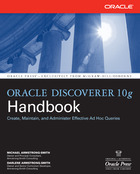The computer I use the most is my laptop running Windows Vista and using the VMWare workstation tool, I have Discoverer Administator, Desktop, Plus and Viewer all working together with the Oracle 11g database on the laptop. I haven't got Discoverer 11g working yet in a VM, but I will try the software in the VM environment before installing elsewhere. You need lots of memory (I have 4Gb) and don't expect stunning performance. But having all the tools installed together is invaluble for testing, evaluation and training.
One thing I really like with this approach is that you can snapshot the VMs at any point in time. Then if you make a mistake, for example, an installation does not work properly, then you can quickly revert the VM back its previous state.
There isn't enough time for a detailed instructions to install all the Discoverer tools but here are the basic steps you need to follow:
- Download and install VMWare workstation (http://www.vmware.com/download/ws/) which you can get on a one month trial.
- Download the Oracle Enterprise Linux DVD from the e-delivery site (http://edelivery.oracle.com/linux). Check which releaes you want as OEL release 5 does not work with some versions of Oracle 10gAS.
- Create a VM of type Red Hat Enterprise Linux. Give the VM the maxium recommended memory. Use a bridged network and specify the hostname and IP address. You can then add the hostname and IP address into the windows hosts file so that you will be able to access Discoverer running in the VM from the windows browser.
- Install the VM tools which is an addition Linux package supplied with the VM workstation.
- Add the ip address and hostname in the /etc/hosts file.
- There are some addition Linux packages (such as gcc and gcc-c++) need to be installed. These are listed in the database and application server installation manuals. All the packages are available in the OEL DVD.
- Some Linux kernal parameters have to be increased. Details of how to do this are in the 11g database installation guide. For an 10gAS installation you need shmmax = 4294967295 and msgmnb = 65536
- There are some other pre-installation tasks for the Oracle 11g in the installation manual. These are adding the oracle, dba and oper unix groups and changing the shell limits.
- Use VM Workstation to create a windows shared drive.
- Download Oracle 11g database (http://www.oracle.com/technology/software/products/database/index.html), unzip in the shared drive and run the installer to install Oracle 11g in the VM.
- Download the Discoverer software e.g. Business Intelligence (http://www.oracle.com/technology/software/products/ias/htdocs/101202.html) for Linux CDs. Unzip into the shared drive and run the installer from the Linux command line. Download and install any patches you need.
- Download the Discoverer tools software for windows (Admin and Desktop) and install on Windows Vista.
- Create a new tablespace for Discoverer and create an End User Layer. You are now ready to start importing objects into the EUL and creating workbooks.
Another thing I like about this approach is that you can run Discoverer Plus and Viewer in the windows browser connecting to the application server and database in the Linux VM just as you would if the Linux was on a separate server. You can create many different VMs, each with different versions, different software tools etc and switch between them to try out different ideas.
I can post more detailed instructions if anyone is interested.







2 comments:
Thanks for laying out the instructions. But, how is the performance and memory usage when running oracle db and applications on VM versus running them natively on Vista?
Mostly you cannot run applications such as Disco Plus and Viewer natively on Vista. The database if anything runs faster in the VM environment, there are less overheads than running it natively. But either way the performance is not good enough to do any useful reporting, just useful for testing and development.
Post a Comment